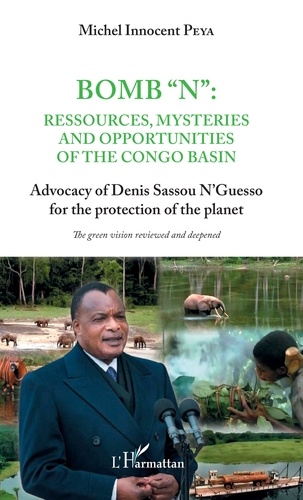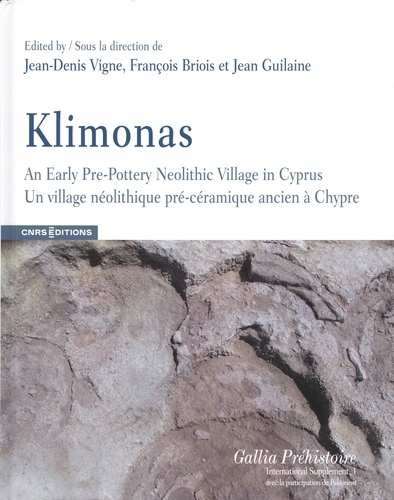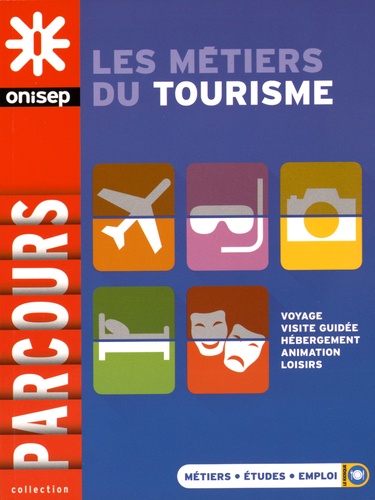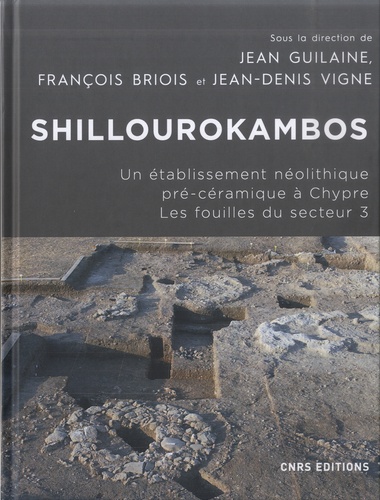community
Extraits

Histoire internationale
Bomb N : ressources, mysteries and opportunities of the Congo basin. Advocacy of Denis Sassou N'Guesso for the protection of the planet
This book of Michel Innocent Peya is devoted to the Congo Basin, the second largest reserve in the world : its natural ressources, its mysteries, legal and institutional frameworks, national, subregional and international levels that protect it. The basin of Congo is an African opportunity for the whole world. Its preservation and its protection over time are an action of conscience, will, commitment, determination and sacrifices for the benefit of humanity. Nature cannot be defending alone ; the Congo Basin finds among his children in love with nature a spokesperson or a soulmate in the person of the President of the Republic of Congo, Denis Sassou N'Guesso. He is one with nature. This is why, time and time again, he cries out against the abusive and irrational exploitation of the Earth, which is the source of delayed natural disasters, irreversible, and mass destruction : the Bomb "N". This saving son of the world demonstrates his involvement by his career and his advocacy at several international, subregional and national summits on protection of the global environment. This book puts in the world place the intrinsic qualities of its international environmental policy, an arduous fight for thirty years for the preservation of nature, the balance of global climate. It plays the role of a climatoecological pivot in the Congo Basin subregion. His climate leadership is the result of coordinated sectoral planned policies, implemented, objectives clearly defined and adapted, credible and effective diplomacy. His sacrifices for humanity, its dedication to the cause of our planet and its management for the future of humanity and future generations give it the status of patrimonium of mankind. Protector as well as defender of the Congo Basin, he receives the blows and the backlash from mafia networks who wish to illegally exploit the huge ressources of this part of the Earth. It reveals to the donor community climatic conditions and to all human civilization the opportunities offered by the Congo (ecotourism, development of the pharmaceutical industry and the market Common Forest of Central African Countries). Peat bogs constitute for the Congo Basin the largest terrestrial reserve of organic carbon. They store twice as much carbon as other forests in the world. He calls on the conscience of climate hinders, because the peat bog is an essential source of ecological stability, a precious reserve of carbon and the cradle of unique flora and fauna to the world and its survival also requires the integration of local communities' indigenous peoples through sustainable projects. This book is a reference tool for understanding and analyzing the basin of Congo, its natural wealth, its legal and institutional framework, in the dynamics of climate-political leadership and its myriad opportunities for the planet. As a result, the author believes that the achievement of these objectives is dependent on climate-political leadership that the Congo Basin space exerts in the concert nations. As it is said in Africa, one finger cannot wash the whole face.
08/2018

Archéologie
Klimonas. Un village néolithique pré-céramique ancien à Chypre, Textes en français et anglais
Klimonas An Early Pre-Pottery Neolithic Village in Cyprus Un village néolithique pré-céramique ancien à Chypre Klimonas is the oldest Mediterranean island village. Occupied ca. 8 800 cal BC, it postpones by several centuries the Neolithic presence in Cyprus, at that time located more than 80 km offshore. The village extended over more than 5, 500 mC, facing the sea, 2 km from the famous pre-pottery site of Shillourokambos and near rich flint outcrops. Excavations (2009-2016) revealed that it was composed of circular or oval earthen buildings 3-6 m in diameter, notched into the slope, modestly fitted out and organised around a semi-buried 10 m communal building. The construction techniques, the abundance of either knapped or polished stone material, together with ornaments, symbolic objects, and plants and animal remains, as well as the 52 radiometric dates, point to the end of the Levantine Pre-Pottery Neolithic A (PPNA). The presence of a communal building, rebuilt numerous times over the course of several decades, also points to the same conclusion. The villagers gathered seeds and fruits and cultivated wild starch and einkorn, recently imported from the continent. They primarily hunted small endemic wild boar, the only large mammal species attested on the island at that time and, secondarily, birds. They did not eat fish or marine shellfish. Domestic dogs, mice and cats brought from the continent also lived in the village. The remains of this cultivator-hunter community testify to the early extension of the Near Eastern Neolithic and to unsuspected seafaring skills, substantially improving our knowledge of the Neolithic transition in the Mediterranean. Klimonas est le plus ancien village insulaire de Méditerranée. Occupé autour de 8 800 av. n. è. , il recule de plusieurs siècles le début de la présence néolithique à Chypre, à cette époque déjà située à plus de 80 km du continent. Le village s'étendait sur 5 500 mC au moins, face à la mer, à 2 km du célèbre site pré-céramique de Shillourokambos et au contact de riches sources de silex. Les fouilles (2009-2016) ont montré qu'il était composé d'édifices de terre crue (bauge) de 3 à 6 m de diamètre, circulaires ou ovalaires, encochés dans la pente, modestement aménagés, organisés autour d'un bâtiment communautaire semi-enterré de 10 m de diamètre. Les techniques de construction, l'abondant mobilier de pierre taillée, le macro-outillage, les parures et objets symboliques, les restes de plantes et les ossements animaux, tout comme les 52 datations radiométriques renvoient à la fin du Néolithique pré-céramique A levantin (PPNA). La présence d'un bâtiment communautaire, plusieurs fois reconstruit en quelques décennies, le confirme. Les villageois pratiquaient la cueillette et cultivaient l'amidonnier et l'engrain sauvages, récemment importés du continent. Ils chassaient un petit sanglier endémique, seule espèce de grand mammifère attestée sur l'île à cette époque, et, secondairement, des oiseaux. Poissons et coquillages marins n'étaient pas consommés. Des chiens domestiques, des souris et des chats de souche continentale vivaient dans le village. Les vestiges de cette communauté d'agriculteurs-chasseurs témoignent de l'extension précoce du premier Néolithique du Proche-Orient et d'une maîtrise insoupçonnée de la navigation. Il enrichit de manière substantielle nos connaissances sur la transition néolithique en Méditerranée.
07/2023

Développement personnel - Orie
Les métiers du tourisme
Première destination touristique mondiale, la France offre des opportunités d'emploi aux jeunes diplômés dans le secteur du tourisme : en agences de voyages, chez les tour-opérateurs, en offices de tourisme, dans l'hôtellerie… Parmi les profils les plus recherchés : les spécialistes du web, du marketing et de la gestion. Cette publication présente 31 MÉTIERS. Ils sont classés en 4 familles : ceux qui conçoivent et vendent les voyages (conseiller voyages, chefs de produit...) ; ceux qui accueillent et hébergent (conseiller en séjour en office de tourisme, directeur de club de vacances...) ; ceux qui font découvrir, animent et divertissent (animateur sport et loisirs, guide accompagnateur...) ; et enfin, ceux qui oeuvrent pour le développement et la promotion des offres (animateur numérique de territoire, responsable webmarketing…). Pour être au plus près du réel, des professionnels racontent leur activité au quotidien, évoquent leurs conditions de travail, les débuts dans le métier, leur parcours. Un reportage chez un tour-opérateur spécialisé dans l'offre de séjours pour les jeunes et jeunes adultes met en scène les métiers de l'organisation et de la vente de voyages. Côté ÉTUDES, l'édition 2015 dresse un panorama de l'offre de formation pour chaque famille de métiers et les formations accessibles bac par bac. Sont ensuite présentées les filières d'études spécifiques au secteur : le bac techno hôtellerie, le BTS tourisme et les autres formations de niveau bac + 2 (en commerce, par exemple) ; les cursus universitaires (licences, licences pro, masters en tourisme) ; les écoles spécialisées et les écoles de commerce. Le lecteur retrouvera des réponses aux questions que se posent les élèves sur le profil requis, les spécialisations possibles, les poursuites d'études... Sans oublier les témoignages de jeunes qui évoquent les grandes étapes de leur parcours de formation. Côté EMPLOI, une enquête permet d'appréhender les dernières tendances du recrutement et les compétences attendues par les différents acteurs du secteur. De jeunes professionnels parlent de leur accès à l'emploi et de leurs premiers pas dans une entreprise et dans un bureau d'études. Le GUIDE PRATIQUE donne les coordonnées des formations traitées, ainsi qu'un mode d'emploi des inscriptions, les ressources Onisep, les sites utiles pour aller plus loin et un lexique. Mots clés : Tourisme, voyage, hôtellerie, animateur sport et loisirs, animateur numérique de territoire SOMMAIRE Tourisme Panorama du secteur Reportage à l'UCPA MÉTIERS Les principaux métiers du secteur regroupés en 4 familles Organisation et vente de voyages : chargé de projet tourisme d'affaires, chef de produit, conseiller voyages, directeur d'agence de voyage, yield manager Accueil hébergement : agent d'accueil en office de tourisme, directeur de centre de vacances Accompagnement et animation : accompagnateur de voyage, guide conférencier, animateur nature, animateur sport et loisirs Développement et promotion : animateur numérique de territoire, community manager, directeur d'office de tourisme, responsable manifestation, responsable webmarketing Les conditions de travail : horaires décalés, temps partiels… Dico métiers : 15 autres professions en mini fiches : activité, compétences requises… Organisation et vente de voyages : agent de réservation, attaché commercial, courtier aérien, directeur de zone Accueil hébergement : directeur d'hôtel, hôtesse d'accueil, réceptionniste, responsable hébergement Accompagnement et animation : animateur de l'architecture et du patrimoine, accompagnateur en moyenne montagne, accompagnateur de tourisme équestre, employé de parc de loisirs, chef de plage Développement et promotion : directeur de parc d'attraction, directeur de club de vacances ÉTUDES Les repères Quelles formations pour quels métiers ? Quels profils pour quelles formations ? 5 questions avant de se lancer Les filières Bac techno hôtellerie Diplômes de l'animation BTS DUT Licences professionnelles Licences et masters Écoles de commerce Écoles spécialisées Mon parcours Vers un master ; vers un bachelor ; vers une licence pro EMPLOI Les entreprises du tourisme Les compétences attendues Les tendances du recrutement Mes débuts en office de tourisme Mes débuts en agence de voyage GUIDE PRATIQUE Carte d'identité des filières Inscriptions, les démarches Carnet d'adresses des formations Sites utiles Ressources Onisep Lexique Index
11/2015

Archéologie
Shillourokambos. Un établissement néolithique pré-céramique à Chypre - Les fouilles du secteur 3
SHILLOUROKAMBOS Les fouilles du secteur 3 The excavations in sector 3 Après être apparue sur le continent asiatique à partir du Xe millénaire av. n. -è. , la " néolithisation " s'est largement propagée. Le site de Shillourokambos à Chypre fait référence pour comprendre les tout débuts de ce processus de diffusion et la première extension des caractères néolithiques en Méditerranée. Fondé vers le milieu du IXe millénaire av. n. -è. , il a été occupé jusqu'à la fin du VIIIe, soit sur une durée d'environ 1500 ans, couvrant tout le Néolithique pré-céramique B du Levant (PPNB). Les zones fouillées entre 1991 et 2004 par la mission " Néolithisation ", avec l'appui de l'Ecole Française d'Athènes, se présentent en deux parties : l'une, au Nord, dénommée " secteur 1 ", l'autre, au Sud, dite " secteur 3 ". La seconde a été fouillée essentiellement entre 1999 et 2003. C'est cette aire qui est aujourd'hui publiée, là où les vestiges des étapes moyenne et récente de l'occupation étaient les mieux attestés et pouvaient se prêter à une certaine analyse spatiale. Elle permet une étude détaillée des périodes évoluées du site, entre 7600 et 7000 av. n. -è. et une approche de ces moments essentiels dans la formation de la culture qui s'épanouira au VIIe millénaire à Khirokitia. Outre l'introduction de certaines espèces animales (le daim, le mouton et probablement le renard), l'émergence massive de l'élevage ovin et bovin et le développement de l'agriculture au tournant des IXe-VIIIe millénaires, on y repère les mutations techniques dans la construction, les outillages lithiques, osseux ou les productions symboliques. C'est dans ce secteur 3 que fut découverte la plus ancienne preuve connue de la domestication du chat. D'importantes informations concernent les perspectives économiques perçues à partir de l'évolution des faunes et des artéfacts. Est aussi abordé l'état sanitaire des populations de l'établissement. Après la publication du secteur 1 en 2011, la communauté archéologique dispose désormais de l'ensemble des données documentaires issues des fouilles de la mission " Néolithisation " à Shillourokambos. After it appeared on the Asian continent from the 10th millennium BC onwards, Neolithisation spread widely. The site of Shillourokambos in Cyprus is a reference to understand the very beginnings of this diffusion process and the first extension of the Neolithic wave in the Mediterranean. Founded around the middle of the 9th millennium BC, it was occupied until the end of the 8th millennium, i. e. over a period of about 1, 500 years, covering the entire Pre-Pottery Neolithic B of the Levant (PPNB). The areas excavated between 1991 and 2004 by the "Neolithisation' project, with the support of the French School at Athens, are presented in two parts : one, in the north, "sector 1', the other, in the south, "sector 3'. The latter was excavated mainly between 1999 and 2003, and it is this area which is now being published. Here, the remains of the middle and recent phases of occupation were best attested and could lend themselves to spatial analysis, enabling a detailed study of the more recent periods of the site, between 7600 and 7000 BC, and of the essential moments in the formation of the culture that flourished in the 7th millennium in Khirokitia. In addition to the introduction of certain animal species (fallow deer, sheep and probably foxes), the massive emergence of sheep and cattle breeding and the development of agriculture at the turn of the 9th-8th millennia, we can also see technical changes in construction, lithic and bone tools and symbolic productions. It is in sector 3 that the earliest known evidence of cat domestication was discovered. Important information concerns the economic perspectives perceived from the evolution of the fauna and artefacts. The health status of the populations in the establishment is also documented and discussed. After the publication of sector 1 in 2011, the archaeological community now has all the documentary data from the excavations of the "Neolithisation' project in Shillourokambos. Ci-dessus : Figurine de picrolite représentant une souris (longueur = 4, 3 cm). En couverture : Vue générale de la fouille du secteur 3 en 2001.
04/2021

